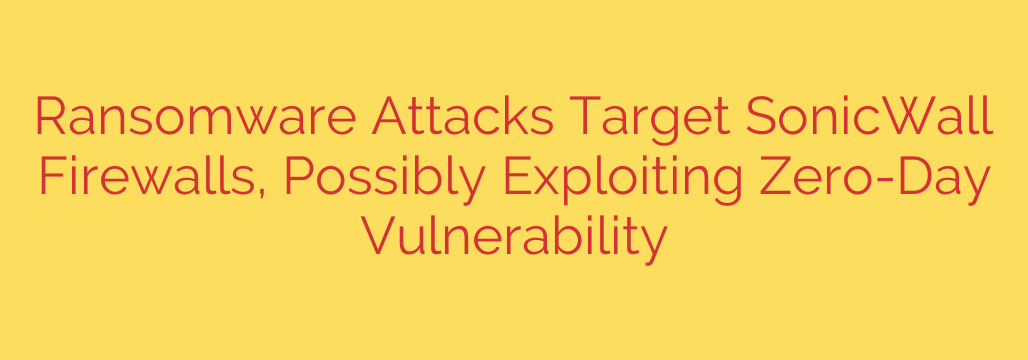
Urgent Security Warning: Ransomware Gangs Exploiting SonicWall Firewalls
A developing cybersecurity threat is actively targeting businesses that rely on SonicWall firewall and remote access products. Security researchers have identified a coordinated ransomware campaign that is exploiting vulnerabilities in these devices to gain access to internal networks, encrypt critical data, and demand hefty ransoms.
This situation is particularly alarming because firewalls are the primary line of defense for most organizations. A successful breach of this foundational security layer can provide attackers with widespread access to your entire digital infrastructure. All organizations using SonicWall products should treat this as a critical alert and take immediate action.
The Nature of the Threat: How Attackers Are Breaching Networks
Threat actors are systematically scanning the internet for vulnerable SonicWall devices. The primary targets of this campaign appear to be the Secure Mobile Access (SMA) and Secure Remote Access (SRA) product lines. These appliances are designed to provide employees with secure remote connections to corporate resources, making them a high-value target.
Once a vulnerable device is identified, the attackers exploit a security flaw to gain administrative control. From there, they can move laterally across the network, disable security software, and deploy their ransomware payload. Because the initial point of entry is a trusted security appliance, the malicious activity may go undetected by other internal monitoring tools until it’s too late.
Identifying At-Risk Devices: Who is Affected?
This ransomware campaign appears to be focused on specific, often outdated, SonicWall hardware. You are considered at high risk if your organization uses:
- End-of-Life (EOL) SRA Series Products: This includes popular models like the SRA 4600/1600. These devices no longer receive security patches from the manufacturer, leaving them permanently vulnerable to known exploits.
- Unpatched SMA 100 Series Devices: While newer, any SMA 100 series appliance that has not had the latest security firmware applied is a potential target.
The exploitation of end-of-life hardware is a serious concern. Running EOL equipment on your network perimeter is a major security liability that creates an open door for attackers.
Is This a Zero-Day Attack?
There is ongoing speculation that attackers may be using a “zero-day” vulnerability—a flaw that is unknown to the vendor and has no available patch. While this has not been officially confirmed, the possibility underscores the severity of the situation.
Whether the exploit is a zero-day or an older, unpatched vulnerability, the outcome is the same: a compromised network and a crippling ransomware attack. The focus must be on immediate mitigation and defense.
How to Protect Your Network: Immediate Steps to Take
If you use SonicWall SMA or SRA products, you must take proactive steps right now to defend your network. Waiting to become a victim is not an option.
Patch and Update Immediately: This is the most critical step. Log in to your MySonicWall account and check for the latest firmware updates for your specific device. If a patch is available for your SMA product, apply it without delay.
Enable Multi-Factor Authentication (MFA): MFA adds a powerful layer of security that can block attackers even if they manage to steal credentials. Enforce MFA on all administrative and user accounts for your SMA, SRA, and firewall devices.
Restrict Management Access from the Internet: Your firewall’s management interface should never be exposed to the public internet. Configure your access rules to ensure the management portal can only be reached from a trusted internal IP address. This dramatically reduces your attack surface.
Isolate or Decommission End-of-Life Devices: If you are still using an EOL SRA device, it cannot be patched. The only secure course of action is to disconnect it from the network immediately and begin the process of replacing it with a modern, supported solution.
Hunt for Signs of Compromise: Review your firewall and network logs for any unusual activity. Look for unrecognized IP addresses, new or modified administrative accounts, or large, unexpected data transfers. If you suspect a breach, engage a professional cybersecurity incident response team to investigate further.
Staying ahead of evolving cyber threats requires constant vigilance. Ensure that robust patch management, proactive hardware lifecycle policies, and layered security controls are central to your organization’s defense strategy.
Source: https://www.helpnetsecurity.com/2025/08/04/sonicwall-firewalls-ssl-vpn-ransomware-akira/








